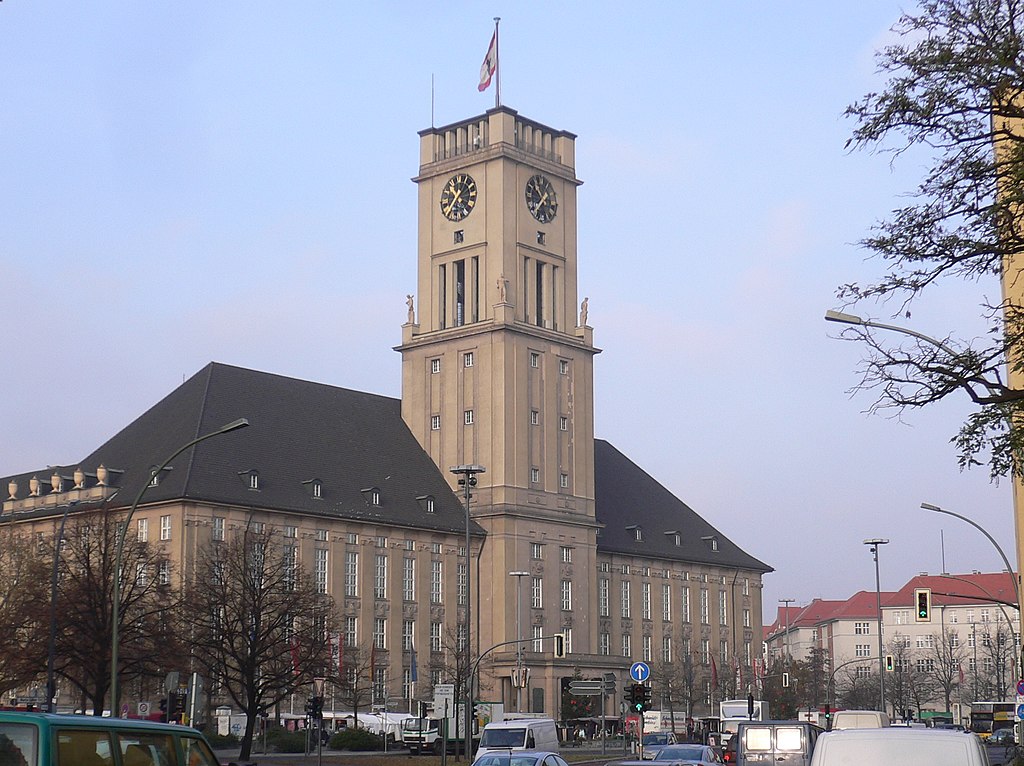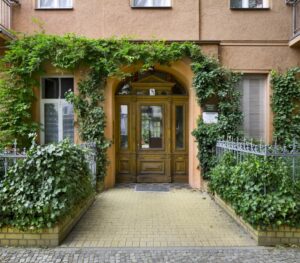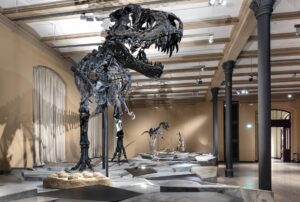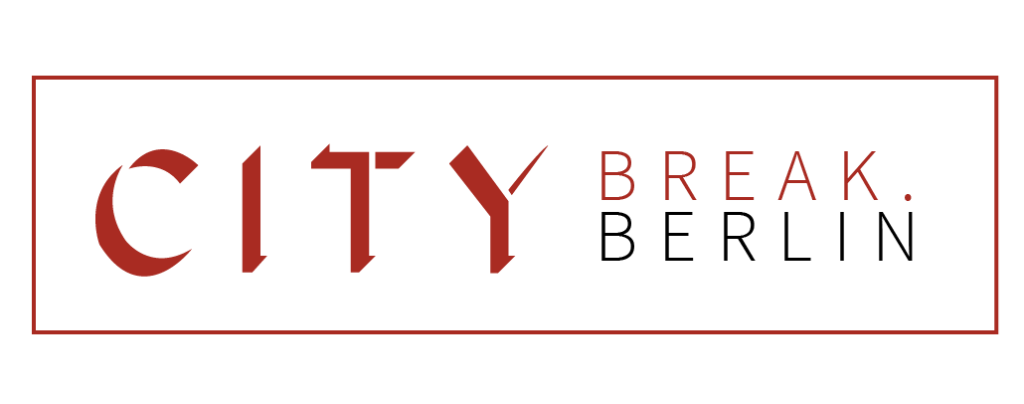In Berlin, history can rip around the city’s landmarks like a deadly tornado, blasting its violent imprint onto the city’s buildings before suddenly veering off, leaving a trail of destruction in its wake. The violent and dramatic events of the 20th century twisted and turned seemingly with no clear destination, only to eventually lose force and vanish as if they had never been.
A legacy of destruction and resilience
Every tornado leaves in its wake certain questions. What happened here? What was it like? And most ominously, when will it strike again? I found myself contemplating these questions on a cool and quiet autumn day, many years ago, when I first laid eyes on the Rathaus Schöneberg, the town hall of the Berlin district of Schöneberg in the city’s wealthier west end, not far from the Victory Column and the Tiergarten. The leaves crunched under my feet as a fitful breeze bothered the soon-to-be bare branches surrounding the hulking old building. It was profoundly moving, and stirred up reflections on the roll random chance plays in the history of this city.

A visit to the Rathaus repays the modest effort needed to get here. For one thing, there are few if any tourists around, so you’ll get the feeling of having stumbled into an authentic corner of the city. But that’s not the primary reason to make the journey. The Schöneberg town hall, at least to me, speaks on a metaphorical level, whispering to the mindful traveler of a certain sense of victimhood that is deeply woven into the fabric of this city’s psychology—a city more often known to the outside world for its role as a perpetrator of crimes. Yet, Schöneberg reminds us that Berlin, along with many of its people, was also a victim of the tornado-like political games that played out across its landscape over the decades. Let’s take a look at what I mean.
From ordinary beginnings to wartime devastation
The Rathaus you see today was completed in 1914, the year the Great War broke out, at a time when Schöneberg was an independent town, albeit one very close to the growing superpower of Berlin proper. And that’s the first thing to really notice about the structure. It was…ordinary. It served as an expression of local pride of course, but fundamentally, it was a building created to serve the daily administrative needs of the local community. This was where you went to register and deregister your presence if you settled here. You paid bills and interacted with local government here. Nothing could be more commonplace.
Schöneberg Rathaus (Town Hall), build to Serve local Needs
Until 1920, when Schöneberg merged with Berlin and formed part of the megapolis. The town hall now found itself part of a much bigger concern, but still served the needs of the locals. The Rathaus entered the Roaring Twenties with a grand promotion but was still doing what it was built to do – serve local needs.
When the Third Reich collapsed in flames in 1945, the humble town hall, once built to serve a mere suburb of Berlin, now found itself on the front lines of history. Street battles between the advancing Soviets and the defending Germans swirled around and inside the town hall. Bullet and shrapnel holes still crater the surface of the building to this day, testifying to the unimaginable violence the town hall witnessed. In fact, between firefights in the streets and damage suffered during the Allied bombing war, the once proud Rathaus found itself severely damaged.
But not so badly hurt that the Soviets were unable to requisition it as a film set in the summer and autumn of 1945, when they made the building into a stand-in for the Reichstag, which was too badly damaged and covered in graffiti to pass muster in Stalin’s Soviet Union. The final fight for the old German parliament building became the defining story for the Soviet government’s burgeoning war memory industry, and a propaganda film was shot inside the town hall’s central staircase and main hall.
Cold War Tensions and the Famous Kennedy Speech
You’d think that going from a local town hall to becoming leading actor in the victorious Soviet Union’s propaganda film industry would be enough to convince you that the building can act as a substitute for the average Berliner’s experiences in the early 20th century – buffeted by the winds of war and political violence – but history had only just sunk its teeth into the war damaged structure.
Repairs took years to complete, but in 1949, when the city was suddenly divided by the creation of the DDR, West Berlin—including the Schöneberg district—found itself without a city hall. All of Berlin’s old administrative buildings were located in the east and had become the headquarters for the communist DDR’s city and state government. As a result, Schöneberg’s town hall was suddenly thrust into service as the city hall for all of West Berlin. This unexpected promotion turned the building into a symbol of the isolated western enclave, surrounded by the communist DDR and thus a powerful emblem of democracy and freedom.
«Isch bin ein Berliner» – Few Speeches had such a Powerful Effect
For this reason, the new city hall’s front steps were the natural venue to play host to U.S. President John F Kennedy in 1963 when he gave his famous “Ich bin ein Berliner” speech, an event commemorated today by a plaque on the façade of the Rathaus. A rousing speech at the time, it’s now become a legendary step on the road to ultimate vindication in the grinding and seemingly endless Cold War. Few political speeches have had such a lasting and powerful effect. Kennedy essentially declared that if one freedom-loving people were oppressed, then all freedom loving people were oppressed and that message of solidarity rallied a West Berlin whose nerves were stretched to the breaking point by the growing power of communism. To explore more about this moment and its impact, visit the Museum THE KENNEDYS, which offers a deeper dive into Kennedy’s legacy and his enduring connection to Berlin.
The modern role of Schöneberg town hall
During the decades that followed, the old Rathaus played host to countless news teams as various groups rallied in the square in front to espouse their various causes. In November 1989, when the Wall unexpectedly came down, it was here that West Berliners gathered to show support and unity.
Today the Schöneberg town hall has once again reverted to what it was built for back in 1914; a local town hall. It’s a hum of ordinary activity and I often wonder how many of the locals contemplate what happened here as they line up for their appointments with functionaries. Imagine your local administration building going from a local venue to the scene of a firefight in one of humankind’s largest battles, to being a Soviet propaganda film actor, to playing host to one of the last century’s most memorable speeches in support of democracy before reverting back to being…boring once again.
Tormented and buffeted by the winds of competing ideologies, a victim to powers greater than itself, in many ways the Schöneberg town hall captures the essence of the Berlin experience in a soft understated way. So head out and visit, and be sure to make time to just sit for a few minutes and imagine the twists and turns of history this place has born witness to. It’s part of what makes Berlin the special destination that it is.
Address:
Schönhausen Palace
Tschaikowskistrasse,
13156 Berlin
Web Address:
Schönhausen Palace – SPSG
Opening Hours:
- Tuesday to Sunday: 10:00 AM – 5:30 PM
- Public Holidays: 11:00 AM – 4:00 PM
Public Transport:
You can reach Schönhausen Palace by taking the S-Bahn:
Lines S2 or S8 to the Pankow station. From there, it’s a short walk to the palace2.





